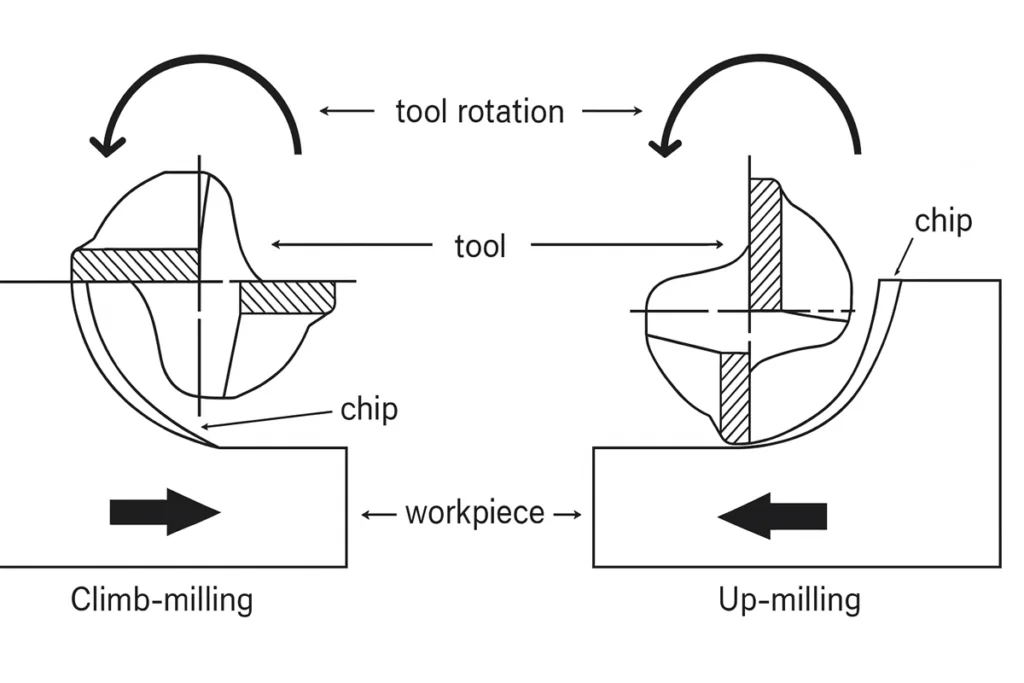Definition of Climb Milling
Climb milling is a machining technique where the cutting tool rotates in the same direction as the feed of the workpiece. In this method, the chip thickness starts at its maximum and reduces to zero, which reduces heat and tool friction. This makes climb milling suitable for CNC machines with rigid setups and low backlash. It often delivers smoother finishes, greater accuracy, and longer tool life compared to conventional milling. However, it requires strong clamping and stable machinery because tool pull-in can cause damage or errors. For modern manufacturing, climb milling is widely used for both metals and plastics where high precision is needed.
Why It Matters for Band Saw and Mill Drill Machines
Climb milling matters because it can improve your machining efficiency, accuracy, and tool lifespan. When you use climb milling, cutting forces press the workpiece into the table, reducing chatter and vibration. This improves surface finish and reduces the chance of dimensional errors. For you, this means less rework, faster production, and more consistent part quality. However, if your machine has excessive backlash or lacks rigidity, climb milling can become dangerous, as the cutter may grab the part and damage both tool and workpiece. Selecting climb milling depends on material hardness, machine stiffness, and the need for finish versus speed. By understanding when to apply climb milling, you can save on tooling costs, improve productivity, and achieve better overall machining results.
Related Terms
Conventional MillingFeed Rate
Chip Load
CNC Machining
Tool Wear
Machine Rigidity
FAQ
What is the key difference between climb milling and conventional milling?
The key difference lies in the direction of tool rotation relative to feed. In climb milling, the tool rotates with the feed, cutting from thick to thin, which reduces friction and heat. In conventional milling, the cutter opposes the feed, starting at zero thickness, which causes rubbing and higher tool wear. This is why climb milling often produces smoother finishes and longer tool life, especially in CNC environments where backlash is controlled.
Does climb milling increase tool life?
Yes, climb milling usually increases tool life because the cutting action reduces rubbing and distributes forces more efficiently. The thick-to-thin chip formation prevents heat buildup at the cutting edge, lowering wear. This extends the useful life of carbide and high-speed steel tools. However, if your machine has backlash, the cutter can grab and damage the tool, so proper machine condition is essential.
What are the risks of climb milling on older machines?
On older or manual milling machines with noticeable backlash, climb milling can pull the workpiece into the cutter unexpectedly. This may cause chatter, dimensional errors, or tool breakage. For this reason, many machinists use conventional milling on less rigid equipment. Climb milling is best reserved for CNC machines with ball screws and tight backlash control.
Which materials benefit most from climb milling?
Materials such as aluminum, brass, and mild steel benefit most because the reduced heat improves surface finish and reduces burr formation. Hardened steels and alloys can also be machined with climb milling when using coated carbide tools, as the lower friction improves tool life. Castings with scale or rough surfaces are better suited to conventional milling to avoid tool grabbing.
How does climb milling affect surface finish?
Climb milling often produces a better surface finish compared to conventional milling. Because the cutter exits the material at zero thickness, it leaves cleaner edges with less tearing or burrs. This is especially important for finishing passes. Still, proper fixturing and rigidity are critical to prevent vibration that can spoil the finish.



